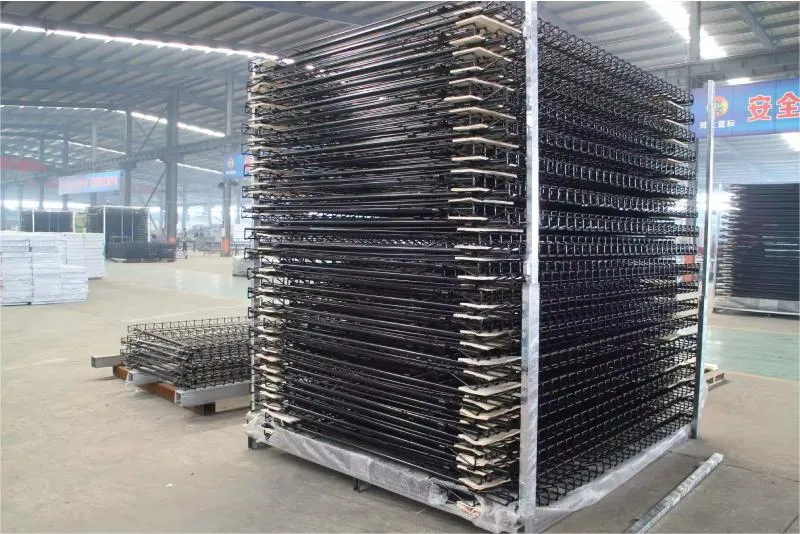
- Afrikaans
- Albanian
- Arabic
- Armenian
- Azerbaijani
- Basque
- Belarusian
- Bengali
- Bosnian
- Bulgarian
- Croatian
- Czech
- Danish
- Dutch
- English
- Esperanto
- Estonian
- Finnish
- French
- Galician
- Georgian
- German
- Greek
- hawaiian
- Hindi
- Hungarian
- Indonesian
- irish
- Italian
- Lao
- Latvian
- Lithuanian
- Luxembourgish
- Macedonian
- Maltese
- Myanmar
- Norwegian
- Polish
- Portuguese
- Romanian
- Russian
- Serbian
- Slovak
- Somali
- Spanish
- Swedish
- Thai
- Turkish
- Turkmen
- Vietnamese
Dec . 05, 2024 15:18 Back to list
welded wire reinforcement sizes
Understanding Welded Wire Reinforcement Sizes
Welded wire reinforcement (WWR) is a critical component in the construction industry, commonly utilized in concrete slabs, walls, and other structural applications to enhance strength and durability. WWR is made from a series of steel wires welded together at their intersections, forming a grid-like structure. This design not only helps in reinforcing concrete but also simplifies the placement process, ensuring uniform distribution of load and reducing the likelihood of cracking in hardened concrete.
Importance of Size Selection
The size of welded wire reinforcement plays a crucial role in its performance and the overall integrity of the concrete structure
. Choosing the right size involves understanding the specific requirements of the project, including load-bearing needs, environmental conditions, and aesthetic considerations. The welded wire reinforcement sizes are defined by the spacing of the wires, their diameter, and the mesh configuration. For instance, common diameters range from 8 to 16 gauge, with smaller gauges quantifying thicker wires.1. Mesh Configuration WWR is available in various mesh configurations, characterized by different spacing between the wires. Standard configurations are often represented in square or rectangular grids, such as 4x4, 6x6, or 8x8 spacing. The choice of mesh size should correspond to the structural requirements; smaller mesh sizes tend to provide better crack control in thinner concrete sections.
2. Load Requirements The load-bearing capacity of a structure heavily depends on the size and configuration of the welded wire reinforcement. Factors such as the type of loads (static or dynamic), magnitude, and distribution must be considered during the design phase. For high-load applications, larger diameters and closer mesh spacing are recommended to ensure adequate support.
3. Environmental Conditions Environmental factors can influence the choice of WWR sizes. In regions prone to seismic activity, for example, a denser mesh may provide better resistance against tensile stresses and deformation. Similarly, in areas exposed to corrosion or aggressive chemicals, utilizing welded wire reinforcement with appropriate protective coatings or higher-grade materials becomes essential.
4. Aesthetic Considerations Depending on the visibility of the reinforcement in the finished structure, aesthetic factors might dictate the selection of WWR sizes. In exposed concrete applications, it is vital to ensure that the reinforcement does not compromise the visual appeal of the structure. Utilizing a consistent mesh size and configuration throughout the project can enhance the overall appearance.
welded wire reinforcement sizes

Common Applications
Welded wire reinforcement is extensively used in various applications, including
- Slabs on Grade WWR is often deployed in residential and commercial concrete slabs. The reinforcement helps control cracking, particularly in slabs subjected to shrinkage and temperature variations.
- Pavements and Driveways In pavements, WWR assists in distributing loads evenly, reducing the potential for surface distress caused by heavy vehicles or freeze-thaw cycles.
- Precast Concrete Products WWR is commonly found in precast elements, including walls and panels, where it provides necessary strength and stability during shipping and installation.
- Retaining Walls The use of welded wire reinforcement in retaining walls helps manage soil pressures and contributes to the longevity of these structures.
Conclusion
In conclusion, understanding the sizes of welded wire reinforcement is vital for ensuring the durability and reliability of concrete structures. The choice of mesh configuration, wire diameter, and spacing should be informed by the specific requirements of each project, incorporating factors such as load demands, environmental conditions, and aesthetic values. Properly selected and installed welded wire reinforcement can significantly enhance the performance of concrete applications, ultimately leading to safer and more resilient structures. As construction standards evolve and technology advances, staying informed about the latest developments in WWR sizes and applications becomes increasingly important for industry professionals.
-
The Vital Role of Wire Mesh in Construction
NewsJul.01,2025
-
The Essential Benefits of Welded Wire Mesh
NewsJul.01,2025
-
Secure Your Property with Field Farm Fence
NewsJul.01,2025
-
Expert Chain Link Fence Installation
NewsJul.01,2025
-
Discover the Versatility of Hexagonal Wire Mesh
NewsJul.01,2025
-
Barbed Wire
NewsJul.01,2025









